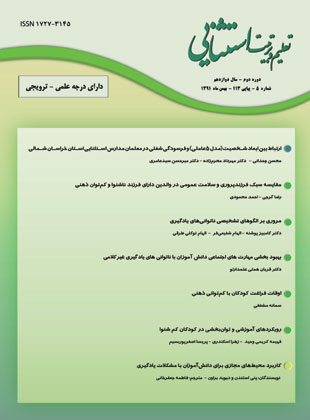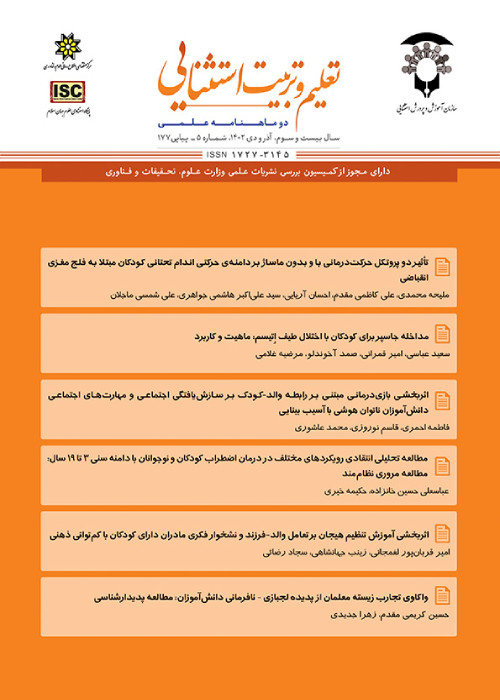فهرست مطالب

نشریه تعلیم و تربیت استثنایی
سال دوازدهم شماره 113 (بهمن 1391)
- تاریخ انتشار: 1391/12/28
- تعداد عناوین: 8
-
-
صفحه 5هدف از این مطالعه، توضیح ارتباط بین ابعاد 5 گانه ی شخصیت و فرسودگی شغلی در معلمان مدارس استثنایی استان خراسان شمالی می باشد.
96 معلم از مدارس استثنایی استان خراسان شمالی، ابزارهای این پژوهش را کامل کردند: 1- پرسشنامه فرسودگی شغلی مسلچ شامل 22آیتم که در سه زیرمقیاس: فرسودگی عاطفی، نقصان موفقیت فردی و مسخ شخصیت، فرسودگی شغلی معلمان را ارزیابی می کند. پرسشنامه مدل 5 عاملی شخصیت با 44 سوال ابعاد مختلف شخصیت شامل: برون گرایی، توافق پذیری، وظیفه شناسی، روان رنجوری و گشودگی به تجارب را ارزیابی می کند. ثبات درونی پرسشنامه ها با استفاده از آزمون آلفای کرونباخ به ترتیب 0.77و 0.81به دست آمد. برای تجزیه و تحلیل اطلاعات از آزمون های کالموگروف اسمیرنوف یک نمونه ای و ضریب همبستگی پیرسون در سطح معنی داری 05/0 ≤ P استفاده شد. نتایج یافته ها نشان داد که افراد با سطوح بالاتر روان رنجوری و سطوح پایین تر برون گرایی، توافق پذیری، وظیفه شناسی و گشودگی به تجارب بیشتر در معرض فرسودگی شغلی قرار می گیرند. بنابراین اگر آموزش و پرورش از یک ارزشیابی شخصیت به عنوان قسمتی از فرایند و سیستم استخدام، استفاده نمایند، می توانند معلمانی که احتمالا دچار فرسودگی شغلی خواهند شد، را شناسایی کنند.
کلیدواژگان: شخصیت، فرسودگی شغلی، مدارس استثنایی -
صفحه 15هدف پژوهش حاضر مقایسه سبک فرزندپروری و میزان سلامت عمومی والدین دارای فرزند ناشنوا و کم توان ذهنی در شهر کرج می باشد. بدین منظور 29نفر از والدین دانش آموزان ناشنوا و 37نفر از والدین دانش آموزان کم توان ذهنی که در سال تحصیلی90-89 در مدارس کرج مشغول به تحصیل بوده اند، انتخاب شده و پرسشنامه های سلامت عمومی و سبک فرزند پروری بامریند را تکمیل نمودند. نتایج نشان داد که بین سلامت عمومی و سبک فرزند پروری این دو گروه از والدین تفاوتی وجود ندارد. همچنین سبک فرزند پروری نمی تواند سلامت عمومی را پیش بینی کند.
کلیدواژگان: خانواده، ناشنوا، کم توان ذهنی، سلامت عمومی -
صفحه 25بررسی متون در حوزه تشخیص ناتوانی یادگیری نشان از وجود چندین مدل جهت بررسی وجود ناتوانی یادگیری دارد. دو نمونه از پرکاربردترین این مدل ها، مدل «ناهماهنگی هوشبهر پیشرفت» و مدل «پاسخ به مداخله» است. با وجود فراگیری این دو مدل و به خصوص مدل ناهماهنگی هوشبهر پیشرفت، انتقاداتی متوجه آن ها است و وجود یک نظریه قوی در صورت استفاده از مدل ناهماهنگی هوشبهر پیشرفت ضروری به نظر می رسد که موجب پدیدآیی و کاربرد رویکرد سومی برای تشخیص ناتوانی یادگیری شده است. در این مقاله سعی شده تا با مروری بر هر سه رویکرد، ملزومات تشخیص حوزه ناتوانی یادگیری بررسی شوند.
کلیدواژگان: مدل تشخیصی ناتوانی یادگیری1، مدل ناهماهنگی هوشبهر- پیشرفت2، مدل پاسخ به مداخله -
صفحه 36پژوهش ها، نشان می دهند که حدود یک سوم دانش آموزان با ناتوانی های یادگیری (که در حال حاضر بزرگترین گروه دانش آموزان با ناتوانی ها را تشکیل می دهند)، ناتوانی های غیرکلامی یا اجتماعی دارند. دانش آموزان با ناتوانی های یادگیری غیرکلامی نه تنها با چالش های تحصیلی مواجه هستند، بلکه در برآوردن انتظارات اجتماعی و بسیاری از خواسته های زندگی نیز مشکل دارند. در واقع مشکلات مهارت-های اجتماعی و برقراری تعاملات بین فردی از ویژگی های اصلی کودکان با ناتوانی های یادگیری غیرکلامی است. مقاله حاضر مشکلات کودکان با ناتوانی های یادگیری غیرکلامی در دوست یابی و حفظ دوستی را به ویژه در محیط مدرسه مورد بحث قرار می دهد. همچنین این مقاله راهبردها و مداخله های عملی از قبیل شروع گفتگو یا بازی با همکلاسی ها، کار کردن با گروه، نشان دادن همدلی، حل تعارض-ها و مدیریت ناکامی برای نارسایی های مهارت های اجتماعی که این دانش آموزان با آنها مواجه هستند، ارائه می دهد.
کلیدواژگان: مهارت های اجتماعی، دانش آموزان، ناتوانی های یادگیری غیرکلامی -
صفحه 52دنیای کودکان دنیای تازگی ها، شادی ها، شادابی ها و شگفتی هاست و بازی، پشتوانه بزرگ شکل گیری شخصیت و رشد مناسب جسمی، ذهنی و روانی کودک است. در حقیقت هر جنبه از رشد و تحول به شکل پیچیده ای با ابعاد دیگر متصل است و اگر به هر طریقی یک جنبه از رشد کودک نادیده گرفته شود و یا صدمه ببیند، او در دستیابی به توانایی های کامل بالقوه اش ناموفق بوده و با شکست مواجه می شود. اوقات فراغت کودک نیز یکی از مواردی است که در رشد و پرورش کودک بسیار موثر و تاثیرگذار است. چرا که گذراندن اوقات فراغت، نیازهای درونی فرد را برآورده می سازد و زمینه رشد ابعاد شخصیت وی را فراهم می نماید.
کلیدواژگان: کم توان ذهنی، اوقات فراغت -
صفحه 57در این مقاله به صورت مروری رویکردهای آموزشی و توان بخشی کم شنوایان مورد بررسی قرار گرفته است. رویکردهای آموزشی و توان بخشی بین دو طیف روش های کاملا دیداری و روش های کاملا شنیداری قرار دارند که با توجه به سازگاری با شرایط کودک و نیازهای او انتخاب می شوند. همه تلاش ها بر آن است که کودک کم شنوا در سطوح علمی هم سطح کودکان عادی باشد. برای دست یابی به این هدف باید خدمات مناسب در اختیار کودک و خانواده قرار گیرد و روش ارتباطی مناسبی برای کودک انتخاب شود. همه رویکردها موجود، خوب هستند، اما هیچ رویکرد واحدی برای همه کودکان کارایی ندارد.
کلیدواژگان: رویکردهای توان بخشی و روش های شنیداری و دیداری -
صفحه 68محیط های مجازی می توانند با استفاده از عناصری چون روایت، تصویر، کلمات و پویانمایی در ترکیب با یکدیگر با روش های تعاملی ساختار مفهومی مناسبی باسطح درک یادگیرنده و علایق اوفراهم سازند. در واقع یادگیرندگان با سرعت مناسب خود می آموزند و می توانند بارها خطا کنند بدون اینکه رایانه از ارائه مجدد تمرین خسته و یا به دلیل کندی عمل یا درشت نویسی بی صبر شود. در چنین محیط های امن یادگیری ثابت شده است که مهارت ها قابل انتقال به محیط واقعی است و در مواردی سرعت اجرا نیز بالاتر بوده است. موانع ابزاری در استفاده از این محیط ها به چهار گروه، استفاده نابه جا از ابزار، پشتیبانی در مواقع لازم، مشکلات حرکتی و عکس العمل کاربر تقسیم می شود. نقش معلمان در کاربرد این محیط ها و ارائه مفاهیم راهبردهای یادگیری به تولید کنندگان این محیط ها و همچنین ارائه تمرین های خوب مطرح است.
کلیدواژگان: اختلال یادگیری، محیط مجازی -
صفحه 79
-
Page 5The purpose of this research is to investigate the correlation between personality dimensions (Five-Factor Model) and job burnout in teachers of exceptional schools in north Khorasan. For this aim 96 teachers of exceptional schools in North Khorasan province (N=141) completed instruments in this study: 1-The Maslach burnout inventory (MBI et al., 1981), contains 22 items that measures three subscales of job burnout: emotional exhaustion, depersonalization, and the lack of a sense of personal accomplishment. 2-Big Five Inventories (BFI, John et al., 1991), with 44 items assess the 5 dimensions of personality: conscientiousness, neuroticism, extraversion, agreeableness, and openness. Cronbach's alpha coefficient was utilized to examine the internal reliability of MBI (r=0.77) and BFI (r=0.81). Data were analyzed with one-sample kolmogrov-smirnov and Person Correlation coefficient, in significant level of P0.05. Our findings indicate that individuals who are higher in neuroticism and lower in extraversion, conscientiousness, and agreeableness are more prone to experience job burnout. So, If education organization use personality assessment as part of their selection systems, then they would be well informed of teachers that are likely to burnout.Keywords: Personality, Job Burnout, Exceptional Schools
-
Page 15The aim of this study was to compare the correlation between parenting styles and general health in parents who had deaf or mental retardation in Karaj city. For this aim 29 parents who had deaf students and 37 parents who had mentally retarded students were recruited and Baumrind's parenting styles questionnaires and General Health questionnaires were used to collect the data. No significant difference was observed between parenting styles and general health in the two groups and parenting styles did not predict the general health.Keywords: Family, Deaf, Mental Retarded, General Health
-
Page 25The analysis of texts in the area of learning disability diagnosis indicates that there are differences for the analysis of learning disability. Two of the most applicable models are "uncoordinated Intelligence coefficient-Progressive" and "intervention prevention" ones. Despite the fact that these two models have had widespread applications especially with the uncoordinated Intelligence coefficient model, there have been some criticism about them. It seems that the existence of one strong theory over the application of uncoordinated Intelligence coefficient -Progressive results in the emergence of a third approach for the diagnosis of learning disability. In this article, there has been an attempt to analyze the necessities for diagnosing the area of learning disability.Keywords: Learning Disorder Diagnosis Model, uncoordinated Intelligence coefficient, Progressive Model, Response to Intervention Model
-
Page 36The researches indicate that about one third of students with learning disabilities (already the largest group of students with disabilities) have nonverbal or social disabilities. Students with nonverbal learning disabilities, then, not only face academic challenges but have difficulty meeting social expectations, as well as many of life’s other demands. Actually, social skills problems and difficulties with interpersonal interactions are the major problems of children with nonverbal learning disabilities. This article discusses the difficulty with which children with social disabilities establish and maintain friendships, as well as the significance of this difficulty within the school setting. The article also illustrates practical classroom strategies and interventions such as entering/initiating conversation or play with classmates, working in groups, exhibiting empathy, resolving conflict, managing frustration that target select social-skill deficits frequently encountered by students with nonverbal learning disabilities.Keywords: Social Skills, Students, Nonverbal Learning Disabilities
-
Page 52Children's world is the world of freshness, happiness, and amazements and play is the best support for the formation of a child's appropriate physical, mental and emotional support.In fact, every aspect of growth and development is in a complex way, connected with other dimensions. If, in any ways, one aspect of child's growth is ignored, or damaged, he/she will fail in reaching his/her potential abilities.A child's leisure time is one of these things that is very effective in his / her growth and education because how a child's leisure time is spent, determines how his/her internal needs are fulfilled and it also provides the field for the development of a child's personality.Keywords: Leisure, Mental, Retarded
-
Page 57In this article, educational and rehabilitational approaches for hard of heaving students have been studied. Educational and rehabilitional approaches are between two spectra of complete visual and audio methods that are selected based on being compatible with a child's conditions and needs.All the efforts are focused on the idea that the hard-of-hearing child will be able to function at the level of a normal child. To reach this goal, appropriate services should be available for the child and his/her family and appropriate communication method should be selected for the child. All the available approaches are good, but not one single approach is effective for all children.Keywords: Rehabilitation Approaches, Audio, Visual Methods
-
Page 68Virtual environments can provide comprehensible structure suitable for the learner's level of understanding and interests by using elements such as story-telling, pictures, words and animation combined with interactive methods. In fact, the learners learn at their own pace and can make mistakes over and over because the computer contrary to people will not get tired of offering the same practices again and again or losing its patience. The obstacles as far as the use of apparatus in the environment are concerned, are divided into four groups:Inappropriate we of tools or apparatus support when needed, difficulties associated with movement and the user's reaction. The role of teacher in the application of these environments and the presentation of concepts in the learning methods and also presentation of good practices are important.Keywords: Virtual environment, learning disorders


